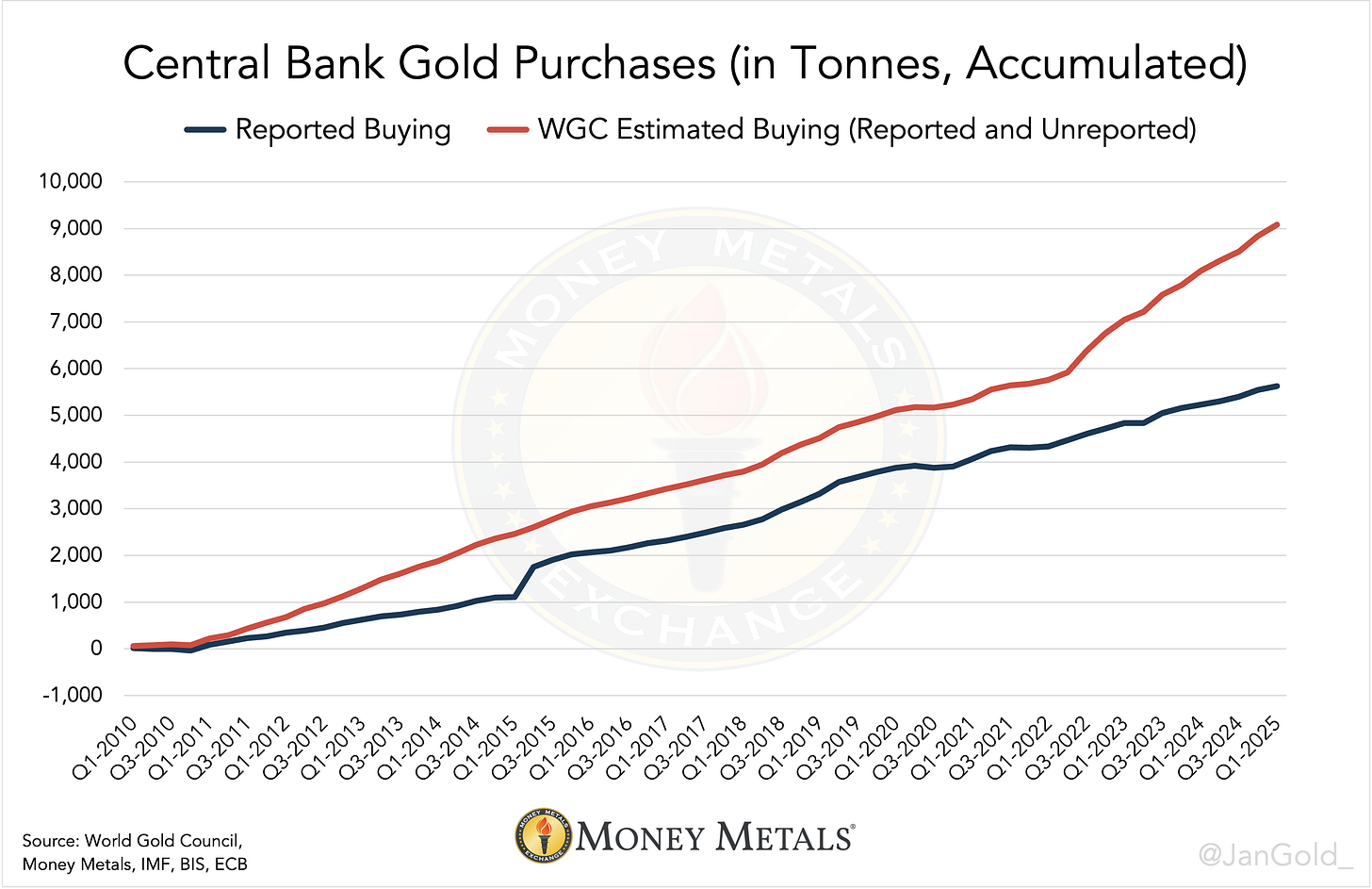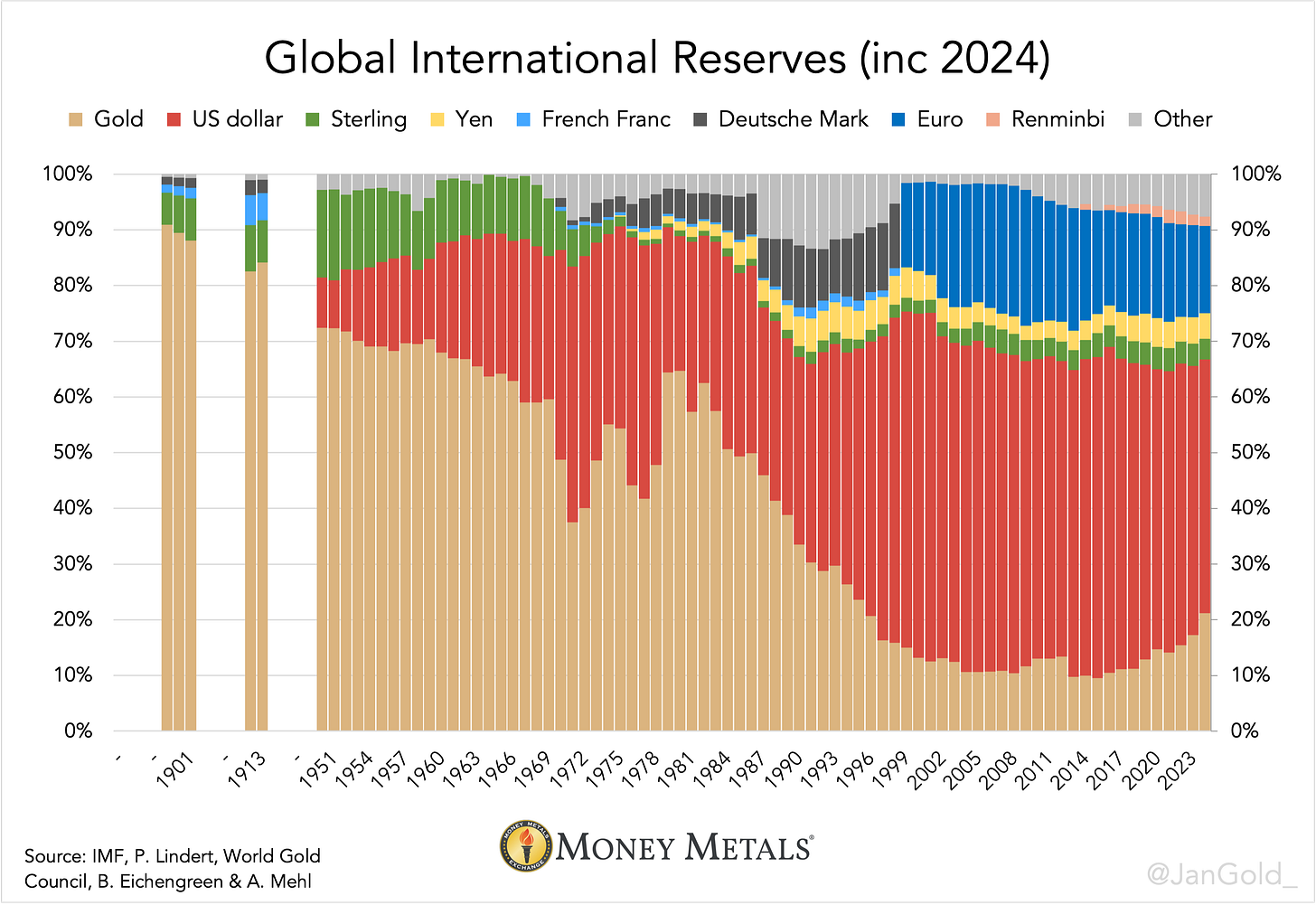Secret Gold Purchases by Chinese Central Bank Reach Mainstream Media
Written by Jan Nieuwenhuijs, originally published at Money Metals.
Bloomberg has finally published an article on covert central bank gold buying (mainly by China)—a topic about which I have been disseminating evidence since February 2023.
Better late than never.
As this “news” reverberates through the mainstream media, more investors will come to realize the sheer size of unreported purchases by central banks—prompted by the biggest credit bubble in history combined with the weaponization of the dollar—and the quicker the price of gold will rise.
I first revealed evidence about secret gold purchases in 2023, after two industry insiders pointed out to me a discrepancy between the World Gold Council’s quarterly estimates on total central bank buying, based on field research, and official data by the IMF, based on what central banks admit to have bought.
“The difference is mostly caused by the People’s Bank of China,” I was told. Mind you, by that time the difference had already accumulated to 2,000 tonnes (today, it’s at 3,500 tonnes). Since then, I have been researching “unreported purchases” by central banks because of their significance to the global financial system.
By March 2024, I was able to confirm that it was China that had taken over control of the gold price from Western markets and had broken gold’s correlation with the 10-year TIPS yield. Three months later, I published an analysis that proved all direct gold exports from the U.K. to China were destined for the Chinese central bank. In November 2024, I found the smoking gun. As direct exports from London to China continued to be elevated, the SGE—China’s central gold bourse—was trading at a discount. Now, why would bullion banks buy gold abroad and sell at a loss on the SGE? They never would, and so the imports from the U.K. had to be for the central bank in Beijing.
Since that time, Goldman Sachs copied my analysis, and the buzz around covert purchases by China has increasingly spread. “Eventually other media will start writing about these huge purchases as well,” I wrote at the time. Sooner or later, the truth will come out.
Since 2024, three different journalists from Bloomberg interviewed me about the details of my analyses, but only recently did they cover the news (June 2025):
Central banks … doubled the pace of their gold purchases in the past three years. They just aren’t declaring them.
Globally, [central banks] are accumulating roughly 80 metric tons of gold a month, … analysts at Goldman Sachs estimate. Most of the buying is secret, although trade data indicates China accounts for a lot of the purchases…
Bloomberg ends by summing up all the evidence I have collected over the years and displays copies of my charts without crediting me. Follow all the links and see for yourself.
Citing a bank as a source is probably mandatory at news outlets such as Bloomberg. Ah, well, my pleasure. “Imitation is the sincerest form of flattery,” a famous writer once said.
Now that the cat is out of the bag, we can expect more reporting by the mainstream media on covert purchases by central banks, and by extension, the actual size of China’s monetary gold reserves and a more realistic approach to gold’s share of global international reserves.
Officially, the PBoC bought a mere 13 tonnes in the first quarter of 2025. My sentinels, though, tell me it bought 144 tonnes (132 tonnes were bought surreptitiously)! Tallying how much gold China’s central bank truly holds produces 5,200 tonnes, making it the second-largest gold-holding nation after the U.S.
I truly hope more journalists will realize that the world official gold reserves are substantially higher than what’s reported by the IMF. Saudi Arabia, for example, also buys gold that’s not reported to the IMF. The chart that it all boils down to, because it demonstrates what’s underpinning the international monetary system, is this one:
Gold is now the fastest-rising international reserve asset, to the detriment of the dollar. Data from the IMF’s Currency Composition of Official Foreign Exchange Reserves has yet to be released for Q1 2015, but in 2024, gold’s share of global international reserves crossed 21%, up 4% year on year, which is the biggest jump in over four decades.
As wars and deficit spending rage on—and as there is virtually zero effort by policymakers to reduce the global debt burden—inflation is the most likely outcome. My expectation is that gold will surpass 50% of international reserves in the years ahead, reaching an estimated $8,000 per fine troy ounce, possibly overshooting to $16,000.




Nice work Jan ... We know who did the original work on this, even if BB chooses not to acknowledge it. Cheers John
How can Bloomberg do this? Outright theft. Appalling. I hope you have complained and requested proper attribution. Also I assume you will have seen this regarding gold overtaking the euro as a reserve asset: https://www.thetimes.com/business-money/economics/article/central-banks-bolster-gold-reserves-amid-geopolitical-tensions-vnndtxpvn